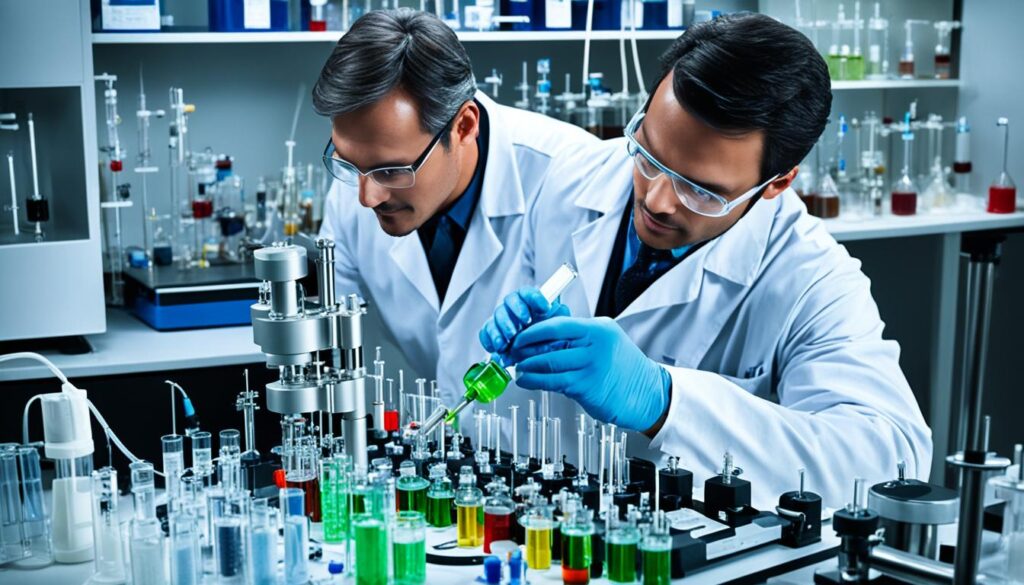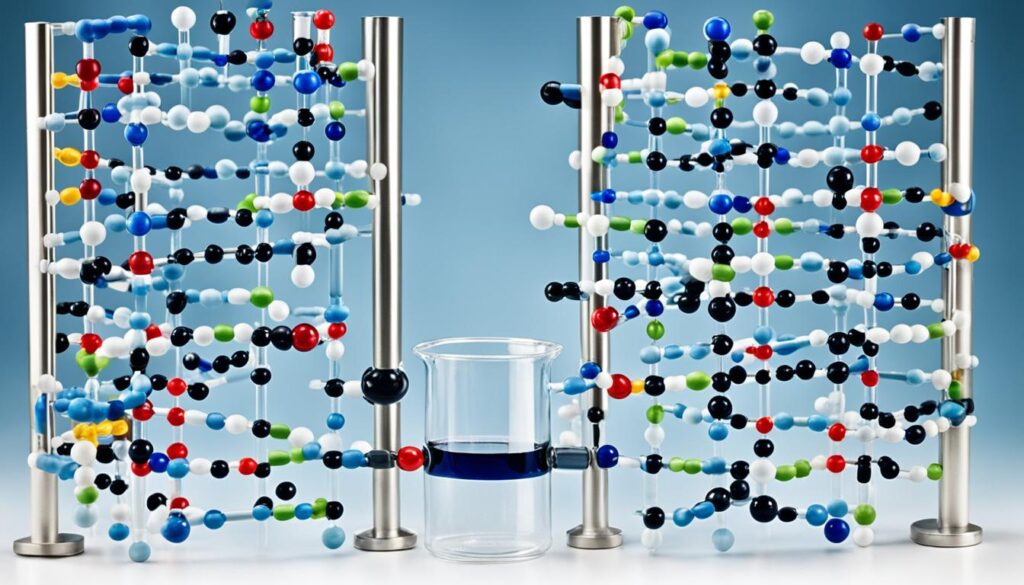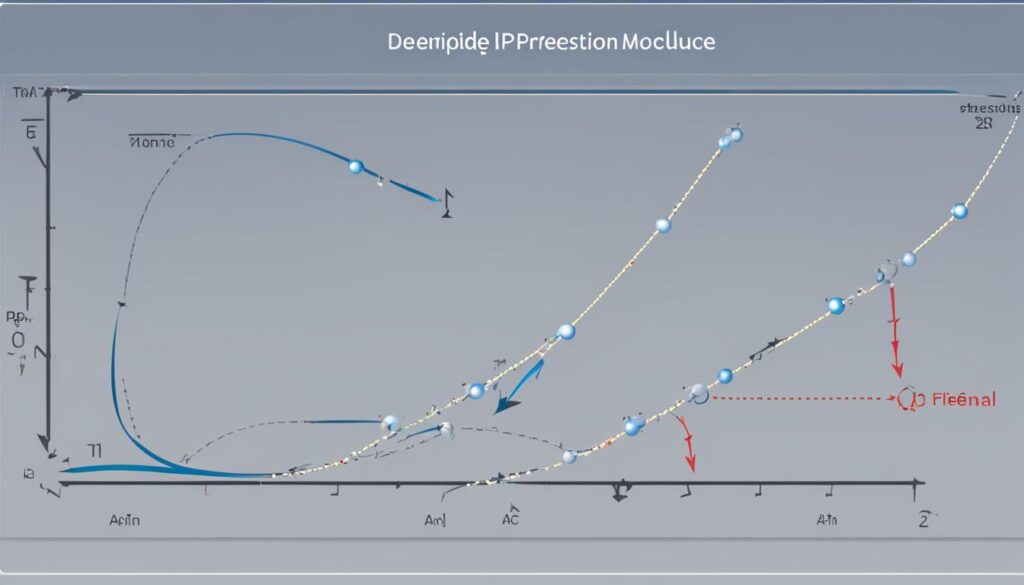A peptide is a chain of amino acids that can be synthesized using chemical methods. Peptides can be short proteins with varying lengths, from 2 amino acids to 100 amino acids. Peptides have various applications in therapeutics, cosmetics, and diagnostics. Chemical synthesis is the most commonly used method to make peptides because it offers advantages such as simplicity, scalability, and the ability to modify the peptide sequence. The synthesis of peptides involves coupling two amino acids together to form a dipeptide, which is achieved by using coupling reagents. Protecting groups are also used to ensure the correct direction of the amino acid sequence during synthesis.
Key Takeaways:
- Peptides are synthesized using chemical methods and have various applications.
- Chemical synthesis allows for scalability and modification of peptide sequences.
- Coupling reagents and protecting groups are used in peptide synthesis.
- Peptides can be short proteins or longer chains of amino acids.
- Chemical synthesis is a widely used method for peptide manufacturing.
The Basic Steps of Peptide Synthesis
Peptide synthesis involves several steps that are essential for the successful production of peptides. These steps include deprotection, coupling, monitoring, cleaving, and purification.
Deprotection
The first step in peptide synthesis is the deprotection of the N-terminus and side chains of the amino acids. Deprotection removes the protecting groups, which are temporarily added to prevent unwanted reactions during the synthesis process.
Coupling
After deprotection, the amino acids are coupled together using coupling reagents to form the peptide bond. This step is crucial for building the peptide chain and requires precise control over reaction conditions.
Monitoring
The reaction progress is monitored to ensure the completion of each coupling step. Common tests, such as the Kaiser test, can be performed to check if the desired reactions have occurred and if the peptide is being formed according to the intended sequence.
Cleaving
Once the desired peptide sequence is achieved, the peptide is cleaved from the resin, which is a solid support used during synthesis. Cleaving allows the peptide to be separated from the resin and prepared for further processing and purification.
Purification
After cleavage, the peptide undergoes purification to remove impurities and obtain a pure peptide product. One commonly used method is high-performance liquid chromatography (HPLC), which separates the peptides based on their chemical properties. HPLC purification ensures a high-quality peptide suitable for various applications.
By following these basic steps, scientists and researchers can effectively synthesize peptides and unlock their potential in various fields such as medicine, cosmetics, and research.

Protecting Groups in Peptide Synthesis
Protecting groups play a vital role in peptide synthesis, ensuring the correct formation of the peptide and preventing unwanted reactions. There are different types of protecting groups used at various stages of the synthesis process.
N-terminus Protecting Groups: Temporary protecting groups such as Fmoc (9-fluorenylmethoxycarbonyl), Boc (tert-butyloxycarbonyl), and Z (benzyloxycarbonyl) are commonly employed to protect the N-terminus of amino acids. These groups shield the amine functionality from undesired reactions during the peptide chain assembly. Importantly, these protecting groups can be selectively removed under specific conditions, allowing for the sequential coupling of amino acids.
C-terminus Protecting Groups: Protecting groups for the C-terminus are not always necessary, especially in solid-phase peptide synthesis (SPPS). In SPPS, the peptide chain is anchored to a solid support, which eliminates the need for additional C-terminus protection. However, in solution-phase peptide synthesis, C-terminus protecting groups may be employed, depending on the specific requirements of the synthesis.
Side Chain Protecting Groups: Side chain protecting groups are utilized to prevent undesired side reactions during the coupling step of peptide synthesis. These protecting groups ensure the selective reaction of the desired functional group and maintain the integrity of the peptide sequence. Common side chain protecting groups include Bzl (benzyl) and tBu (tert-butyl).
Proper selection and removal of protecting groups are essential for successful peptide synthesis. The choice of protecting groups depends on the specific amino acids involved and the desired peptide sequence. Protecting groups ensure the accurate assembly of the peptide chain, leading to the production of high-quality peptides for various applications.
Solid-Phase Peptide Synthesis vs Solution-Phase Peptide Synthesis
When it comes to peptide synthesis, two main methods are widely used: solid-phase peptide synthesis (SPPS) and solution-phase peptide synthesis. While both methods have their advantages and applications, SPPS is the most commonly employed technique due to its efficiency and versatility.
Solid-Phase Peptide Synthesis (SPPS)
In SPPS, the C-terminal amino acid is attached to a solid support, such as a resin or a polymer. This attachment allows for step-wise synthesis, where amino acids are added one by one to build the peptide sequence. SPPS offers several benefits:
- Rapidity: SPPS enables fast peptide synthesis, making it ideal for producing peptides in large quantities.
- Automation: The process can be automated, ensuring reproducibility and minimizing errors.
- High-quality peptide production: SPPS results in highly pure and well-defined peptides suitable for various applications.
Solution-Phase Peptide Synthesis
While SPPS is the go-to method for most peptide synthesis needs, solution-phase synthesis has its merits in specific cases. Solution-phase synthesis is typically employed for the synthesis of short peptides or peptides with modified C-termini that are not amenable to SPPS. It involves the coupling of amino acids in a solution, allowing for the direct formation of the peptide bond.

Comparison Table: Solid-Phase Peptide Synthesis vs Solution-Phase Peptide Synthesis
| Solid-Phase Peptide Synthesis (SPPS) | Solution-Phase Peptide Synthesis | |
|---|---|---|
| Method | Step-wise synthesis on a solid support | Coupling of amino acids in a solution |
| Applications | General peptide synthesis | Short peptides or modified C-termini |
| Advantages |
|
|
Deprotection and Cleavage of Peptides
After the synthesis of the peptide, it is necessary to remove the protecting groups. This process, known as deprotection, involves taking off the protecting groups on the N-terminus and side chains first, followed by the removal of the protecting group on the C-terminus.
Different deprotection methods are employed depending on the protecting groups used during synthesis. Careful consideration is given to ensure selective deprotection without affecting the integrity of the peptide.
To react with any reactive species generated during deprotection, scavengers such as water, anisole, or thiol derivatives are added. These scavengers help prevent the formation of undesired by-products and maintain the integrity of the peptide.
Once complete deprotection is achieved, the peptide is cleaved from the resin. Cleavage cocktails containing appropriate reagents are used for this process. Cleavage may involve breaking peptide-resin bonds or specific chemical reactions to release the purified peptide from the solid support.

| Deprotection Method | Protecting Group | Scavenger |
|---|---|---|
| Hydrogen Fluoride (HF) Cleavage | T-butyl (tBu) | Anisole |
| Acidolysis | Benzyl (Bzl) | Thioanisole |
| Base Cleavage | Benzyloxycarbonyl (Cbz) | Water |
Peptide Purification
After the cleavage of the peptide from the resin, the next crucial step is to purify the peptide to ensure its quality and remove any impurities. One of the most widely used methods for peptide purification is high-performance liquid chromatography (HPLC). HPLC is a powerful technique that separates the desired peptide from impurities based on their chemical properties.
During HPLC purification, the peptide sample is injected into a chromatographic column, where it interacts with a mobile phase. The components of the sample, including impurities and other molecules, are separated as they navigate through the column. The separation is based on factors such as size, polarity, and hydrophobicity. With careful optimization of the column, sample, and mobile phase conditions, HPLC can achieve excellent separation and purification of peptides.
HPLC purification is typically carried out on preparative or semi-preparative columns, depending on the scale of the purification process. The guidelines for HPLC purification vary depending on the specific peptide being purified, including the peptide length, hydrophobicity, and overall complexity. By employing HPLC purification, researchers and manufacturers can obtain highly pure peptides that meet their desired quality standards, ensuring the reliability and reproducibility of their experiments or applications.
FAQ
What is peptide synthesis?
Peptide synthesis is the process of creating a chain of amino acids, known as a peptide, using chemical methods. It is commonly used to produce peptides for various applications in therapeutics, cosmetics, and diagnostics.
What are the steps involved in peptide synthesis?
The steps involved in peptide synthesis include deprotection of the N-terminus and side chains of the amino acids, coupling of the amino acids using coupling reagents, repetition of deprotection and coupling steps, cleavage of the peptide from the resin, and purification using methods such as HPLC.
Why are protecting groups used in peptide synthesis?
Protecting groups are used in peptide synthesis to prevent unwanted reactions and ensure the correct formation of the peptide. They are used for the N-terminus, C-terminus, and side chains of amino acids.
What are the main methods of peptide synthesis?
The two main methods of peptide synthesis are solid-phase peptide synthesis (SPPS) and solution-phase peptide synthesis. SPPS is the most commonly used method due to its simplicity, scalability, and ability to automate. Solution-phase synthesis is used for specific cases.
What is the process of deprotection and cleavage in peptide synthesis?
Deprotection involves the removal of protecting groups from the N-terminus, side chains, and C-terminus of the amino acids. Cleavage is the process of separating the peptide from the resin. Scavengers are used to react with reactive species generated during deprotection.
How is peptide purification done?
Peptide purification is commonly done using high-performance liquid chromatography (HPLC). HPLC separates the desired peptide from impurities based on their chemical properties. Preparative or semi-preparative columns are used for purification.
Source Links
- https://www.bachem.com/news/how-are-peptides-made/
- https://www.thermofisher.com/us/en/home/life-science/protein-biology/protein-biology-learning-center/protein-biology-resource-library/pierce-protein-methods/peptide-synthesis.html
- https://www.peptide.com/resources/solid-phase-peptide-synthesis/how-to-synthesize-a-peptide/






